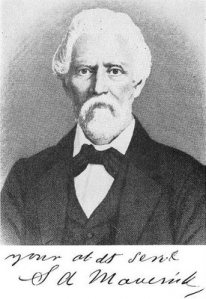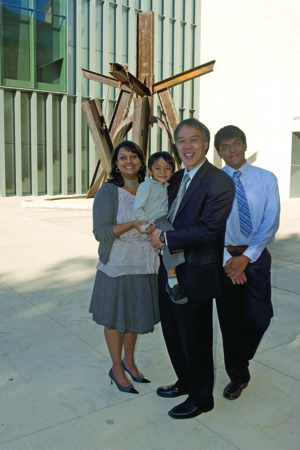Dance is Alive and Well and Living in Detroit

Four dancers from Epiphany Dance perform in Harmonie Park during DDCF.
“If you’re going to do a triple, it’s got to be fast.” The spacious stage of the Detroit Music Hall stage looked skeletal as thirteen young women learned a complex piece of jazz choreography. Well, thirteen young women and one virtuosic young man, no more than eleven years old, whose pirouettes were right on par with the rest of the class. The sounds of Cher and Chaka Khan echoed off of the art deco ceiling of the theater before sinking into the rich red velvet of the seats. Dancers pulsated with energy, hitting each beat meticulously for just a moment before leaping into the next one.
My weekend at Detroit Dance City Festival was full of moments like that. The Festival, in its third year during Summer 2015, is the brainchild of ARTLAB J founder and dance innovator Joori Jung. Originally from Seoul, Korea, she moved to Detroit and, in two short years, took it upon herself to make Detroit more open to the international dance community. The weekend of the Detroit Dance City Festival was a conglomerate of art makers, performers, and the business-minded people making dance a sustainable practice. Some attendees did all three.
Mind you, I was very much a fly on the wall here. I Irish-danced as a girl, but I had hung up the hard shoes a while ago and was perfectly content with observing this perfectly postured world as it spun around me. Workshops like the one in the Music Hall were happening every day and ranged in focus from jazz to modern to West African. I watched many of them, but my personal favorite was taught by Beatrice Capote, a dancer in Camille A. Brown and Dancers company. Once the class began, the West African drum beat hardly ever stopped. Beatrice built small gesture upon gesture, introducing this unique style of dance to a large group of students foreign to the form, until the room was full of stomping feet and flailing arms, all somehow keeping time to the impossibly quick rhythm. One of the most important elements of this style, Beatrice stressed, was connection. West African dance is a form of communication, a way to celebrate the extraordinary elements of the ordinary day. Certainly this was true of the workshop. What began as a group of serious, focused young artists melted into a crowd of smiling young people, improvising, applauding, and laughing.
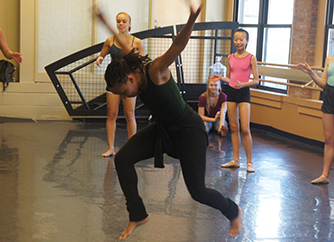
Beatrice Capote leads an improv session during her workshop.
That evening, Beatrice would perform a portion of Black Girl — A Linguistic Play with her fellow company members from Camille A. Brown and Dancers at the DDCF Gala, the cornerstone of the weekend. To begin the conversation on some of the elements of this work, she asked her workshop participants what they thought about when they heard the words “black girl.” There was an awkward silence, and I admit I was glad I didn’t have to come up with a response; there is no right answer to that question, but there are definitely wrong ones, and everyone treaded carefully with choice of words. Beatrice had obviously asked this question before and was familiar with this reaction. In fact, she said that it was this tension surrounding the concept of “black girl” identity that prompted Camille A. Brown and her dancers to create this work. Using what Beatrice referred to as “vernacular dance,” the company has referenced playground interactions, sibling bickering, handshakes, and pop culture (if you look closely you can spot Beyoncé’s infamous Single Ladies chug) to elevate the experience of young black women. The performance was moving, and the piece in its final state, coming to UMS in February, will not be one to miss.
The weekend was full of performances. I spent my late afternoons in the charming Harmonie Park across from the bustling Carr Center watching local dance troupes perform in beautiful sunshine. One group of four young girls from Epiphany Dance, a Detroit-based company, stood out in particular. Clad in bright yellows and greens, they glided across the stage in beautifully executed choreography. As I watched I couldn’t help but connect their passion with what is at the heart of Camille A. Brown’s work; these girls, sharing what they love without reserve or restraint, seemed to me to encompass what Camille might seek to capture in her art. Many of these outdoor performances felt just as joyful. I loved the way the brief season of Michigan warmth was animated through hip-hop, lyrical, rhythmic gymnastics, even Polynesian dance.
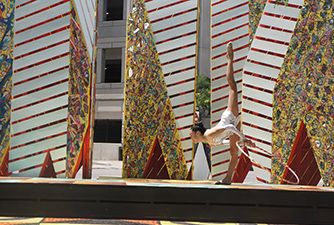
An exciting rhythmic gymnastic performance in Harmonie Park.
In the evenings, the art makers shined at the Choreographer Showcases. The first two nights of the Festival featured over twenty pieces from choreographers from across the country. I, like many, am a bit of a novice to the current trends in dance, and was pleasantly surprised to discover that dance is capable of much more than I initially assumed. I learned that, contrary to popular belief, dance does not need music. I saw multiple pieces in partial or total silence, pieces that kept me completely engaged. Dance can also use video, voice, and live music to elevate movement. One of my favorites used traditional mime techniques melded to modern hip hop to create a metaphor for immigrating to the states. I was mesmerized. As one participant told me, “The modern movement blew open the possibilities of dance, and we’ve been trying to figure out to do with it ever since.”
While performance was certainly the focus of the Festival, the weekend had an undercurrent of stimulating conversations about sustaining dance in Detroit and strengthening the international dance community. Through a series of panel discussions, I learned about the numerous organizations in Southeast Michigan who are dedicated to helping dance and those who create it thrive. Shivangee Pandya represented Creative Many, a group that advocates for the development of professional artists in Michigan. They provide legal aid, educate on the fundamentals of becoming a non-profit, and assist in contract work. They recognize that being a professional artist means running a business, and their dedication to the establishment of solid foundations for these artists shows a profound respect the dignity of creative work. I had the chance to chat with Lynne Friman of Culturesource and IXITI, a website that posts any and all creative performances and events happening in and around Detroit. With a shock of purple and blue hair and a big smile, she was able to list at least three people in the Detroit arts scene that you must know, all within the first five minutes of my chatting with her. She, and many others in attendance, are living advocates for the growing number of dance, theater, and music artists in the area, and they’re dying to tell you about it.
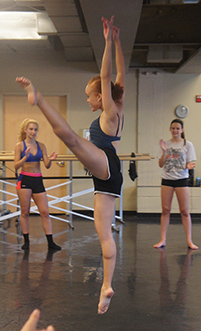
A dancer leaps during Beatrice’s workshop.
Equal parts celebration and exploration, the Detroit Dance City Festival never shied away from asking what dance is capable of. It wondered if it needed music, how it could be filmed, what props it could use, and who had access to it. The result was a real sense of community, a group of people who are willing to decide where dance can go from here. They will create the work, fund it, and find the audience, and they’ll enjoy the process just as much as the final product. It was exciting to be in on the secret that Detroit is rising fast on the global dance scale. Something tells me it won’t stay a secret for long.
UMS Artists in “Residence”: Spring 2015 Update!
In fall 2014, UMS launched a new Artist in “Residence” program. Five local artists were chosen to take “residence” at our performances. It’s been a pleasure getting to know this cohort throughout the year and exciting to see how UMS performances have helped inspire new works!
Curious what they’ve been up to? Check out the AiR update below, and come chat with the artists in residence in person at our 2015-2016 Season Launch Party on Friday, April 24, 2015 from 5-7:30 pm in Ann Arbor’s Rackham Graduate Building.
Our Artists in Residence have been busy. Have you heard the news?!
Playwright, actor, director, and teaching artist Emilio Rodriguez is co-producing the Metro Detroit Fringe Festival in late June. His play “Swimming While Drowning” will have a reading at the Activate Midwest festival at Western Michigan University in June and also by the Latino/a Theatre Commons in Chicago in July.
Writer Robert James Russell just released his chapbook of short stories Don’t Ask Me to Spell It Out. His next book, a Western called Mesilla —is due out this fall.
Additionally, Russell will be joining the New Harmony Writers Workshop as a Fellow this June at the University of Southern Indiana. He is also honored to be leading two writing workshops in May and June at the Great Lakes Commonwealth of Letters (GLCL) in Grand Rapids.
Pianist Nicholas Gable is thrilled to announce a tentative chamber music performance list: (dates TBA)
César Franck’s Violin Sonata in A Major
Sergei Rachmaninoff’s G Minor Trio (Elégiaque)
Rachmaninoff’s Cello Sonata in G Minor
Painter, drawer, and sculpturist Carolyn Reed Barritt’s artwork was chosen to be reproduced on vinyl and installed on a traffic box downtown Ann Arbor as part of Ann Arbor’s Power Art! public art exhibition. Additionally, three paintings from her Lost Empire series were purchased by Ruth’s Chris Steak House for display in their new Ann Arbor restaurant. Barritt is currently working on a new series of sculptures which she’s very excited about.
Many thanks to our Artists for a wonderful inaugural AiR program. Catch them at the UMS 2015-2016 Season Launch party on Friday, April 24th!
Resident Update: Artist Carolyn Reed Barritt on Compagnie Non Nova
Painter Carolyn Reed Barritt is a UMS Artist in Residence this season. We’ve asked five artists from across disciplines to take “residence” at our performances and to share the work these performances inspire.
Carolyn attended Compagnie Non Nova‘s performance of Afternoon of a Foehn this past weekend at Skyline High School’s black box theatre. She shares her thoughts on the performance:
“I didn’t think I could be so enraptured by ordinary plastic bags…The performance is mastered chaos — each fan controlled to create an airflow which allows the bag puppets to twirl, float and wrestle with each other and their creator in a confined space. Sometimes the puppets skate together along the floor; sometimes it seems as though they are tying to escape by floating up to the ceiling. Sometimes they seem to attack each other. Their creator moves with them, allowing them to dance and fight until they turn on him, using the wind that animates them to envelope and smother him with their bodies, making him so angry he destroys them all. The audio track ebbs and flows from sublime to sinister, the bag puppets go from charming to vindictive, the single, silent actor, ghost-like and imperious — all this in a home-made wind vortex.
If you’re lucky enough to be in Ann Arbor Michigan right now, there are more shows this coming weekend (February 19 – 21, 2015). Otherwise I hope this show comes to you someday!”
Read the full post on Carolyn’s blog
Interested in learning more? Read our interview with Carolyn.
Resident Update: Writer Robert James Russell
Writer Robert James Russell is a UMS Artist in Residence this season. We’ve asked five artists from across disciplines to take “residence” at our performances and to share the work these performances inspire. Robert shares his experiences on dance, music, and his new novel below:
“When I applied for the UMS Artists-in-Residency program, my goal was to see performances and use that inspiration to craft a new novel. I’m beyond thrilled at the chance to experience wonderful performances and explore the role of music and dance in my work—both of which have always been crucial to my mental health, and to my ability to immerse myself in a project.
So far, I’ve seen the following UMS performances, all radically different from one another—and each has inspired me in vastly different ways:
- Ryoji Ikeda (superposition)
- Mariinsky Orchestra
- Compagnie Marie Chouinard
- eighth blackbird
See, this isn’t just writing a novel, coming up with a story and characters, but in this instance I am creating an entirely new place: a fictional island in Lake Superior, documenting the entire history of the island, of the people that lived (and, in the present of my novel, still live) there. Typically when I write I find some style of music that works for that story and I listen to the same record(s) over and over as I write, never growing tire of the repetition. In this instance, though, since it’s not just story, but history…and this immersion in different types of performances has been utterly liberating:
- superposition taught me, even through the wondrous noise, about the use of silence in my work.
- The Mariinsky Orchestra inspired me to embrace more bombastic/dramatic sections of the story.
- Watching the Compagnie Marie Chouinard showed me how to re-think interactions of characters, how they meet in the story, but also how these characters interact with the island itself.
- eighth blackbird encouraged me to embrace the unexpected—to travel different routes in the storytelling, in the creation of the island’s history, of its inhabitants, and to avoid the predictable…to really dig deep and do something unique.
 Each of these performances has taught me re-think what I know about art and inspiration, and they are with me every day when I write. In addition to a seemingly never-ending list of books I flip through daily—various back-issues of National Geographic featuring articles about Isle Royale (used as inspiration); a 1937 manual called Wolf and Coyote Trapping; the unbelievably inspiring/gorgeous Atlas of Remote Islands by Judith Schalansky; others—I am constantly harkening back to each performance, remembering them, and making sure that they are not forgotten. And I am reminded with every word I put down how astonishing and remarkable the performing arts are…how important they are to the production of any art.”
Each of these performances has taught me re-think what I know about art and inspiration, and they are with me every day when I write. In addition to a seemingly never-ending list of books I flip through daily—various back-issues of National Geographic featuring articles about Isle Royale (used as inspiration); a 1937 manual called Wolf and Coyote Trapping; the unbelievably inspiring/gorgeous Atlas of Remote Islands by Judith Schalansky; others—I am constantly harkening back to each performance, remembering them, and making sure that they are not forgotten. And I am reminded with every word I put down how astonishing and remarkable the performing arts are…how important they are to the production of any art.”
——
Robert James Russell is the author of two upcoming books: the collection Don’t Ask Me to Spell It Out (WhiskeyPaper Press, 2015) and the novel Mesilla (Dock Street Press, 2015). His first novel, Sea of Trees, was published in 2012. He is the founding editor of the literary journals Midwestern Gothic and CHEAP POP. You can find him online at robertjamesrussell.com and @robhollywood.”
Interested in learning more? Read our interview with Robert.
Photo and Audio Tour of Detroit’s Mexicantown
Editor’s note: The Mariachi Vargas de Tecalitlán return to Ann Arbor on April 1, 2016.
Mariachi Vargas is one of the most highly regarded ensembles in the history of mariachi. Founded in a small city near Jalisco by Don Gaspar Vargas in the 1890s, this band basically invented the modern mariachi, and five generations later, is still playing today.
To explore the music’s connection to our community, we asked WDET’s Martina Guzmán to give us a tour of Detroit’s Mexicantown, a neighborhood with over 100 years of history in the city. Check out the tour below, with images by Detroit-based photographer Erik Howard.
We also visited the LA SED (Latin Americans for Social and Economic Development) Senior Center in the neighborhood, where we heard many stories about the community importance of mariachi music.

“I was born and raised through Mariachis,” Lupe Guzmán says. “Don’t believe what I say, but Mariachi music is like medicine. Mariachi…you have one on side and another Mariachi on the other side, and they make you alive.”

Beatrice Gonzales was a singer when she was younger. She bought the dress in this photo in Mexico 35 years ago. She says that she is still in love with the tradition of Mariachis.

Arnulfo Guiterrez’ favorite song is “El Mariachi Loco.” It’s a LA SED Senior Center favorite for dancing.

UMS thanks AARP for coordinating ticketing and transportation for a group of LA SED seniors to attend the Mariachi Vargas de Tecalitlán performance.
Youth Performances at UMS
Photos from the 11/12 Youth Performance Season [Click to Enlarge] – Questions at AnDa Union (Left) & Dancing at Rebirth Brass Band (Right).
As the school year begins to wind down, I look back at another amazing season at UMS. As the elementary vocal music teacher at Mitchell School in Ann Arbor, I have been fortunate enough to bring my students to UMS concerts for more than 10 years.
When I pause to reflect on the professional, first-class groups that my young students have seen, it is absolutely astonishing. I’m thinking now about World Music groups, and the effects these concerts have had on our students.
When Amalia Hernandez Ballet Folklorico de Mexico appeared in 2006, it triggered a celebration of Hispanic culture in our school. The whole school attended the concert (first time ever!) and the event resonated throughout the school year as we studied and played Latin music. I applied for and received a grant to buy authentic Latin percussion instruments for my classroom. These are enjoyed by every grade level to this day, and have become increasingly important as our school’s Hispanic population continues to grow. I also remember our students being overwhelmed and moved by the performance we attended of The Children of Uganda. The story of these children and their astonishing talents resonated deeply with Mitchell Students.
I’m wondering who else out there has something to say about their experiences with UMS world music youth concerts.
- Did you find that your students were especially moved by the performances?
- Were you able to see carry over effects into the school year and beyond?
- Do your students remember the performances years later, recalling such sights and sounds as new instruments they may have seen in the shows?
 Let’s start a conversation to compare experiences and to help UMS continue its great efforts to bring such diverse performers to Ann Arbor. Thanks.
Let’s start a conversation to compare experiences and to help UMS continue its great efforts to bring such diverse performers to Ann Arbor. Thanks.
Rosalie Koenig, Mitchell Elementary School
Student Collaborations at The Kennedy Center

From Left to Right: Martha Cargo, Jordan Brooks, Eric Siu, Erik Haasler, Rimbo Wong, Kari Dion, Lee Dionne.
A few weeks ago, I traveled to Washington D.C and had the pleasure of playing with musicians spanning the entire country. The University of Michigan participates annually in the Kennedy Center’s conservatory project, for which college students from around the country are brought together to collaborate.
This year, Three Cities Marathon project showcased new and contemporary music from recent composers. I was ecstatic to be U-M’s nominee this year; I had always admired the Kennedy Center’s commitment to young artists, but I never thought I would get to be a part of it.
I had never been to Washington D.C before, so after I arrived, I immediately wanted to see the sights. I walked around Georgetown and through the monuments, admiring the city. Finally on Saturday morning, I met and rehearsed with my fellow student musicians from around the country.
The piece I was invited to perform was Martin Smolka’s Die Seele auf dem Esel (The Sole on the Donkey) for Piccolo, Eb Clarinet, Cello, Viola, Violin, Percussion, and Piano; non-traditional as far as instrumentation goes.
The piccolo player was Martha from Manhattan School of Music, the cellist was Erik from San Francisco, Rimbo was the violist from the Cleveland Institute of Music, the violinist was Eric from Rice, the percussionist was Jordan from Berkley, and the Pianist was Lee from Yale. Seven extraordinary musicians, yet, our piece was very hard to put together.
When modern music is notated, it tends to be more ambiguous and exceedingly more complicated metrically, making rehearsal’s very difficult. My part actually instructed me to play certain notes however I wanted to, for any duration, until the “rain stick” decided to stop. So crazy!
We had very little time to put the piece together; the rehearsals were Saturday, and the performance was Sunday afternoon. But, despite the complicated notations and the shortness of the stay, the performance was a wonderful experience. Having the pleasure to play with such great musicians who have the ability to hear and react perfectly to everything was very special.
The other composers featured on the concert were Johannes Maria Staud and György Kurtág. Probably the most memorable piece from the whole concert was Strad’s work Incipit II for trombone and bass drum. This seems fairly normal, however, Strad’s piece is meant to be played by one person. The performer is instructed to play a kick drum, the trombone, as well as scream and grunt during the piece. It was one of the most involved solo works I had ever heard; it was brilliant!
Playing Eb clarinet has always been very fun for me, but I had never imagined it would take me so many different places. Being part of the Three Cities Marathon project was especially fun. Seeing a new city, performing new music, and connecting to more wonderful musicians; thanks so much U of M for the opportunity.
Check out the link to the performance!
— Kari Dion is a U-M Master’s Clarinet student and UMS Digital Media Intern. She is also part of Akropolis quintet.
Voices in the Community: Home School Students & Youth Performances
Photo: Dancing on stage at the Rebirth Brass Band Youth performance. Photo by Mark Gjukich Photography.
We love offering youth performances throughout our season.
The performances are attended by classes of students, but home-schooled students also get together in groups in order for the performances. We asked a few of the home-schooled families to talk about their experiences.
One family attended a performance in February:
The Chamber Ensemble of the Shanghai Chinese Orchestra was fantastic! We didn’t really know what to expect going into it. We thought it would be relaxing, and interesting and that it would likely make us hungry for Chinese food, all of which it did. But, it was so much more! The personality delivered through the voice of the director and the enthusiasm of the performers transcended any language barrier. The explanations and stories that were shared before each piece transformed the music and gave it an ethereal beauty. It’s effect remained with us throughout the day. It has forever changed the way we will enjoy Chinese music; we will always be listening to see if we can guess at the story that the instruments are telling. As homeschoolers we strive to take every advantage of the cultural benefits that so enhance the learning experience.
Another family attended two youth performances in one day:
When the subject of Maya, our 13 year old comes up in conversation, questions about home school often arise. Volumes have been spoken and written about the potential of home schooling and why so many do it with such passion. High on my list of “whys” is evidenced by the kind of day we had with the help of our friends at UMS.
We live, work and raise our children in a community that connects with the arts in ways that few other cities are fortunate to enjoy. In no small measure this is why we are the community we are. On February 10th UMS sponsored two widely divergent but equally compelling musical performances. We’ve been attending UMS youth performances for years with a home school group. It wasn’t a matter of if we would attend but which of these two performances, scheduled 1 hour apart, we would choose. With the help of the UMS volunteers, we chose both.
Our home school group was graced by a lively and culturally illuminating hour of traditional Chinese chamber music. The charming director of the Shanghai Orchestra and his translator did a terrific job of educating and entertaining. Just as the last applause died away the UMS team dismissed us first and we were off. We entered Hill Auditorium and were whisked to our section just in time for the opening applause as Conductor Morgan took the stage to lead the Sphinx Orchestra. Whew. Now for something completely different and equally joyful and enriching. The Sphinx laureates were inspiring in their virtuosity and presence. I am glad not to have had to do the judges work… and equally glad not to have had to make the choice between these extraordinary musical events.
Bonus Video: Chamber Ensemble of the Shanghai Chinese Orchestra also visited Logan Elementary:
Do you remember attending arts events or performances as a student? What effect do you think these experiences have?
RSC Creative Residency in Ann Arbor
Photo: On stage during the RSC residency in March, 2001. More of our photos with the RSC here.
Next week, the Royal Shakespeare Company will visit Ann Arbor for its 2012 creative residency (March 10-20, 2012).
During three previous residencies presented by UMS, the RSC performed four history plays (“Henry VI, parts i, ii, and iii” and “Richard III” in 2001), a world premiere stage adaptation of Salman Rushdie’s “Midnight’s Children,” (alongside Shakespeare’s “Coriolanus” and “The Merry Wives of Windsor,” 2003) and “Antony and Cleopatra” and “The Tempest” starring Patrick Stewart (alongside “Julius Caesar” in 2006).
This residency, similar to one in 2010 which led to the production of three new plays, is a working residency and a collaboration with U-M, during which a creative team of six actors, two directors, voice and movement coaches, and the RSC’s dramaturg join actors from the New York-based LAByrinth Theater Company to focus on the development of two plays it hopes to produce during upcoming seasons: Pushkin’s “Boris Godunov” (directed by RSC artistic director Michael Boyd) and “The Orphan of Zhao,” the first Chinese play produced in Europe (directed by chief associate director Gregory Doran).
Creative Residency 2012 Public Events
Admission is free, though seating may be limited.
Tuesday, March 13, 5 pm
James Fenton Reading
Kalamazoo Room at the Michigan League
Friday, March 16, 4 pm
“The Orphan of Zhao” Presentation
Blau Auditorium, Ross School of Business
Saturday, March 17
9 am — “Word and Action: An Acting Master Class” with Gregory Doran
4 pm — “Bringing ‘Creative Project 2012’ to the Stage: The Audience and the Director” featuring Gregory Doran, RSC Chief Associate Director
Blau Auditorium, Ross School of Business
Sunday, March 18, 4 pm
“Drama in Translation” (a roundtable discussion) and “A Conversation with Michael Boyd, RSC Artistic Director, and Ralph Williams”
Blau Auditorium, Ross School of Business
Monday, March 19, 4:30 pm
Reading of “Boris Godunov”
Blau Auditorium, Ross School of Business
Have you attended RSC events in the past? Share your experiences below.
UMS Night School Report – Einstein on the Beach
On the topic of “maverick,” one of the words being used to describe the artists on offer in the Renegade series, I learned at yesterday’s first UMS “Night School” session that its primary meaning is an “unbranded calf or yearling.” The term comes from one Samuel Augustus Maverick (1803-1870), an American rancher who refused to brand his own calves so that he could claim any unbranded calf he found as his own. Needless to say, he wasn’t a popular guy in his neighborhood. More broadly, the word “maverick” refers to something—a calf, for instance, or maybe a composer—that lacks any markings of ownership. I suppose that’s what John McCain had in mind in four years ago, but I’m glad UMS is reclaiming the word for us in something like its original context, and I’m intrigued to think of artists like Robert Wilson and Olivier Messiaen (whose From the Canyons to the Stars is next up in the Renegade series) as stubborn ranchers who flat-out won’t, or can’t, brand their work.
Lots of talk at last night’s class—attended by more than 70 people—about what to expect at next week’s Einstein on the Beach. Instructor Mark Clague went over what EoB is (an opera with poetic texts, recitative, an orchestra pit, and a mythic hero) and is not (Aida). Of particular note are the work’s five-hour length and non-narrative structure, and the attendant challenges for audience members. If I leave to go to the bathroom, how will I know what I’ve missed? people wanted to know. Just how repetitive is it? I caught up with Dennis Carter, head usher for UMS, who came to last night’s class to prepare himself for next week’s event.
Inspired? What do you think it means to be a “renegade”?
Robert Wilson: Video 50
Robert Wilson fans will have much to do in Ann Arbor this winter.
UMS is presenting preview performances of Einstein on the Beach, an opera by Robert Wilson and Philip Glass, January 20-22. Absolute Wilson, a film which chronicles the epic life, times, and creative genius of theater director Robert Wilson, will be screened on January 9. The film screening is free.
Photo: Robert Wilson. “Video 50,” 1978. Courtesy Electronic Arts Intermix (EAI), New York
In conjunction, UMMA’s Video 50 curates Robert Wilson’s “smaller-scale” experiments in video. Guest Curator Ruth Keffer describes the exhibit:
Video 50 consists of a randomly arranged set of 30-second “episodes”; counting occasional repeats and alternate versions, the 50 pieces of the title number nearly 100. Some of these episodes are static to the point of resembling still-lifes; others are self-contained vignettes that begin and end—or seem to end; any narrative resolution is teasingly withheld. With its use of early video techniques and the highly stylized, fashion-world look of its actors, Video 50 seems dated, but the way in which Wilson wields his domestic-gothic vocabulary is classic surrealism: everyday objects and settings made mysterious or comical or alien by their bizarre juxtaposition to one another, and by an equally nonsensical and cheerfully manipulative score of music and sound effects.
Read the full article in UMMA Magazine.
[VIDEO] Messiah Memories: Soloists Meg Bragle and Mary Wilson
UMS first presented Handel’s Messiah in December of 1879. Over several weeks, we released a series of Messiah Memories webisodes from everyone involved over the years.
In this episode, Meg Bragle (mezzo-soprano) and Mary Wilson (soprano), Messiah soloists and good friends, talk about the fun of coming back to Ann Arbor to perform in Messiah:
Previously:
Episode 1: Jerry Blackstone, long-time Messiah conductor, forgets his jacket on the day of the performance.
Episode 2: Father Timothy Dombrowski, choral union member for over forty years, remembers “The Bat out of Hill.”
Episode 3: Megan Sajewski, resident of Martha Cook dormitory, talks about co-chairing the annual Martha Cook Messiah Dinner.
Community Spotlight: Rani Kotha
Editor’s Note: UMS presents Cloud Gate Dance Theatre of Taiwan, performing “Water Stains on the Wall,” on Oct 21 & 22 at the Power Center. Rani Kotha and Howard Hu are co-sponsoring the performance along with Frank Legacki and Alicia Torres.
I’ve worked with Rani Kotha and Howard Hu for the past five years here at the UM School of Public Health, and I think of them primarily as science people—Rani’s the executive director of the UM Center for Global Health, and Howard chairs the Department of Environmental Health Sciences at SPH. So I was intrigued to see they’re co-sponsoring next week’s performance by Cloud Gate Dance Theatre of Taiwan. I asked Rani why, and she told me that she and Howard are big fans of UMS—Rani’s a board member—and strongly advocates for the arts. Howard’s mother studied music and taught him the piano, and Rani danced and sang, and their 17-year-old son, Krishna, now plays piano and violin and performs with his school orchestra. Rani says although Krishna’s quite science-oriented, “music has really helped him to nurture the more creative part of his brain and has really built his confidence.”
UMS and the arts are also “very much a community thing,” she adds. Howard’s parents came to the States from China, and he’s got family in Taiwan. Rani’s family emigrated from India. Through Cloud Gate (and later in the season Zakir Hussain, whose UMS performance they’re also co-sponsoring) they’re able to share their cultural heritage with the A2 community.
Rani cottoned onto the idea of co-sponsoring Cloud Gate after hearing UMS programming director Michael Kondziolka describe the company’s work—and show this YouTube video [link]—to the board during a meeting of the programming committee last year. “the performers were so beautiful and lithe and physically strong, and there was almost this acrobatic feel to them, and they had such precision in their movement, but the performance was very simple and austere and meditative … very Asian.” She decided then and there that if they could swing it, she and Howard would help bring Cloud Gate to town.
To hear Rani tell it, meetings of the programming committee are themselves riveting performances. (Maybe UMS should sell tickets.) Here’s her take:
“My absolutely favorite committee meetings are the programming committee meetings, run by Michael Kondziolka. They allow board members to get inside his head and understand what goes into building the UMS season. The meetings are usually three to four hours long, but time goes by so quickly. Michael shares what goes into building a season—recruiting talent; developing long-term relationships with performers; embracing a wide variety of subjects, different genres, styles, different geographic regions of the country and world. It’s almost like a chess game—trying to make the dates work, figuring out where the performers need to be next in their tour, how it will benefit the University of Michigan to have these performers in residence, which venue is going to work, how much preparation will go into the venue to make it work, the cost to cover tickets. So much goes into it. My decisions on what to buy tickets for are based almost entirely on the content of these meetings. I know very little, and then I’ll listen to a recording, or Michael will show a YouTube clip, or he’ll tell a story, and you feel, oh my god, I’m going to buy tickets to that. And by the end of it you feel you need a second job, because I’ve just decided I’m going to buy 30 tickets to things. It’s my favorite activity of the board and such a privilege to be a part of.”
[VIDEO] Cloud Gate Dance Theatre of Taiwan
In a long-awaited performance, Cloud Gate Dance Theatre of Taiwan presents Lin Hwai-min’s newest work, Water Stains on the Wall, on October 21 & 22 at the Power Center.
Below, Cloud Gate Dance Theatre of Taiwan in the words of Ann Arbor’s Taiwanese community.
And an interview with Artistic Director Lin Hwai-min upon his arrival in Ann Arbor:
And a little bit more about his inspirations:
UMS on Film Series
Every summer, we come up with about three dozen companion-films to the UMS main-stage season. We’ve narrowed the list to five this year – two in the fall, and three in the winter. Each expands our understanding of artists and their cultures, and reveals emotions and ideas behind the creative process.
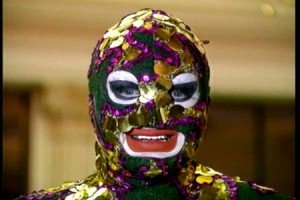 In the fall, the films highlight deep cultural expressions which grow from communities of shared heritage. In the winter, the films tie in with UMS’s PURE MICHIGAN RENEGADE series, which focuses on artistic innovation and experimentation. We’ve created a mini film festival, Pure Michigan Renegade on Film, to extend the renegade idea and explore other artists who have created new arts frontiers.
In the fall, the films highlight deep cultural expressions which grow from communities of shared heritage. In the winter, the films tie in with UMS’s PURE MICHIGAN RENEGADE series, which focuses on artistic innovation and experimentation. We’ve created a mini film festival, Pure Michigan Renegade on Film, to extend the renegade idea and explore other artists who have created new arts frontiers.
All films (except one! see below) are presented in the U-M Museum of Art Stern Auditorium (525 S. State Street) and are free and open to the public.
Pure Michigan Renegade on Film:
Helicopter String Quartet
(1995, Frank Sheffer, 81 min.)
Wednesday, March 7, 7:00 PM at the Michigan Theater (603 E. Liberty)
Tickets: $10 general admission; $7 students/seniors/UMS and Mich Theater members; $5 AAFF members
Purchase Tickets Here
The UMS Renegade on Film series culminates at the Michigan Theatre in collaboration with the Ann Arbor Film Festival (celebrating its 50th anniversary in March 2012!!). The curators at AAFF chose an amazing documentary that captures the renegade spirit and provides a fabulous lead-in to the San Francisco Symphony American Mavericks concerts. In one of the most certifiably eccentric musical events of the late 20th century, German composer Karlheinz Stockhausen designed and executed the performance: four string quartet members playing an original piece by Stockhausen in four separate helicopters, all flying simultaneously. The sound was then routed to a central location and mixed; the work premiered, in turn, at the 1995 Holland Festival. Frank Scheffer’s film Helicopter String Quartet depicts the behind-the-scenes preparations for this event; Scheffer also conducts and films an extended conversation with Stockhausen in which the creator discusses the conception and execution of his composition and then breaks it down analytically. Featuring music by Karlheinz Stockhausen, performed by the Arditti String Quartet. Co-presented with the Ann Arbor Film Festival in partnership with the Michigan Theater, in collaboration with the U-M Museum of Art.
Past Films…
Fauborg Tremé: The Untold Story of Black New Orleans
(2008, Dawn Logsdon, 69 min.)
Tuesday, October 11, 7 pm
Connected with UMS’s presentation of A Night in Tremé: the Musical Majesty of New Orleans, this documentary follows Lolis Eric Elie, a New Orleans newspaperman on a tour of his city, a tour that becomes a reflection on the relevance of history, folded into a love letter to the storied New Orleans neighborhood, Faubourg Tremé. Arguably the oldest black neighborhood in America and the birthplace of jazz, Faubourg Tremé was home to the largest community of free black people in the Deep South during slavery, and it was also a hotbed of political ferment. In Faubourg Tremé, black and white, free and enslaved, rich and poor co-habitated, collaborated, and clashed to create America’s first Civil Rights movement and a unique American culture. Wynton Marsalis is the executive producer of the film, which also features an original jazz score by Derrick Hodge. Introducing the film is U-M American Culture faculty member Bruce Conforth, whom some may remember from last season’s series on American Roots music.
AnDa Union: From the Steppes to the City (with director Q&A)
(2011, Sophie Lascelles and Tim Pearce)
Tuesday, November 8, 7 pm
Before AnDa Union takes the stage at Hill Auditorium, filmmakers Sophie Lascelles and Tim Pearce will screen their new documentary, which follows the group of 14 musicians who all hail from the Xilingol Grassland area of Inner Mongolia. The film premieres at the London Film Festival on October 13, and Ann Arbor will be one of the first to screen it after its debut. AnDa Union is part of a musical movement that is finding inspiration in old and forgotten folk music from the nomadic herdsman cultures of Inner and Outer Mongolia, drawing on a repertoire of music that all but disappeared during China’s recent tumultuous past. Tim and Sophie will be here in Ann Arbor to introduce the film, and take audience questions after the screening.
Absolute Wilson
(2006, Katharina Otto-Bernstein, 105 min.)
Tuesday, January 10, 7 pm
Absolute Wilson chronicles the epic life, times, and creative genius of theater director Robert Wilson. More than a biography, the film is an exhilarating exploration of the transformative power of creativity – and an inspiring tale of a boy who grew up as an outsider in the American South only to become a fearless artist with a profoundly original perspective on the world. The narrative reveals the deep connections between Wilson’s childhood experiences and the haunting beauty of his monumental works, which include the theatrical sensations “Deafman Glance,” “Einstein on the Beach” and “The CIVIL WarS.”
The Legend of Leigh Bowery (with director Q&A)
(2002, Charles Atlas, 60 min.)
Monday, February 13, 7 pm
Renegade filmmaker Charles Atlas (who worked extensively with the late choreographer Merce Cunningham) introduces his 2002 documentary The Legend of Leigh Bowery. Artist/designer/performer/provocateur Leigh Bowery designed costumes and performed with the enfant terrible of British dance Michael Clark, designed one-of-a-kind outrageous costumes and creations for himself, ran one of the most outrageous clubs of the 1980s London club scene (later immortalized in Boy George’s Broadway musical “Taboo”), and was the muse of the great British painter Lucian Freud. The film includes interviews with Damien Hirst, Bella Freud, Cerith Wyn Evans, Boy George, and his widow Nicola Bowery. Charles Atlas will participate in audience Q&A immediately following the film. This film is co-presented with the U-M Institute for the Humanities which hosts Charles Atlas’s video installation “Joints Array” in February 2012.
Performances for the Whole Family: Filling the master calendar with UMS events
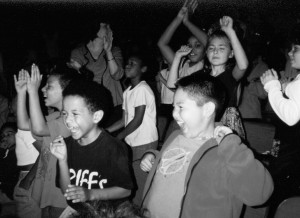 Part of the excitement of coming back to town at the end of summer is collecting all the calendars—Ann Arbor Public School’s holiday and half-day calendar, Huron High School’s band calendar, Clague Middle School’s orchestra calendar, King Elementary School’s PTO calendar, the crew calendar, the soccer calendar, the academic games calendar, University of Michigan’s football calendar, Washtenaw Community College Lifelong Learning calendar, Rec and Ed, Parks and Rec, etc.—whew!—and finally sitting down to map them all out onto one big master calendar in order to see what our year is going to look like.
Part of the excitement of coming back to town at the end of summer is collecting all the calendars—Ann Arbor Public School’s holiday and half-day calendar, Huron High School’s band calendar, Clague Middle School’s orchestra calendar, King Elementary School’s PTO calendar, the crew calendar, the soccer calendar, the academic games calendar, University of Michigan’s football calendar, Washtenaw Community College Lifelong Learning calendar, Rec and Ed, Parks and Rec, etc.—whew!—and finally sitting down to map them all out onto one big master calendar in order to see what our year is going to look like.
My favorite calendar to pore over with the kids is the one from University Musical Society (UMS).
This year, the University of Michigan Center for Chinese Studies is celebrating its 50th anniversary. As usual for an academic department, they have all sorts of lectures and films and special events and conferences planned. University of Michigan Museum of Art is supporting this celebration with a contemporary Chinese woodblock print exhibit. University Musical Society is supporting this celebration with an Asia performance series. I am excited.
When the UMS catalog arrives, the kids keep grabbing it away from one another. They dog-ear the pages that interest them. They recall other concerts and dance performances we have attended.
Little Brother is captivated by the photograph of the old woman and old man sitting in trashcans. What could that possibly be? (Gate Theatre of Dublin) How to explain Beckett’s “Endgame” and “Watt” to a seven year old?
Our pianist, Niu Niu, complains (again) that she likes playing piano but does not like watching piano, but when we begin discuss how the dazzling Yuja Wang recently rocked the Hollywood Bowl with her very short very tight very sexy orange dress, about which reviewer Mark Swed wrote: “Her dress Tuesday was so short and tight, that had there been any less of it, the Bowl might have been forced to restrict admission to any music lover under 18 not accompanied by an adult.” Oh, and her legendary speed, too. Now Niu Niu is convinced. Our first concert marked on the calendar.
Cloud Gate Dance Theatre of Taiwan is my choice. I have already heard many Taiwanese American friends discussing how the choreography is inspired by Chinese calligraphy and classical landscape painting. Local Chinese calligraphers will be demonstrating and displaying their work before the performance to connect these two artforms.
Hao Hao wants to go see AnDa Union from Inner Mongolia. I thought it was because her great-grandfather was born in Inner Mongolia, but really it is because she remembers the Mongolian throat singers we once heard perform at the Ann Arbor District Library.
M is intrigued by the Chamber Ensemble of the Shanghai Chinese Orchestra because she knows more about Chinese music than any of us, but the Ballet Preljocal looks amazing. An antithesis of Disney’s Snow White? It looks dark and grim and sexy and strange—irresistible for teenagers dressed all in black.
Now, big sigh, the tickets.
I was so grateful when UMS began their teen ticket program a few years ago, at last an affordable way to bring my teenagers to UMS programs. I was even more grateful when I was able to go with the children’s school field trips as a chaperone. This year, UMS is launching a new UMS “Kids Club” program for students in grades 3 to 12: “Two weeks before opening night, parents can purchase up to two kids’ tickets for $10 each with the purchase of an adult ticket for $20.”
Great! So now we can take the whole family.










